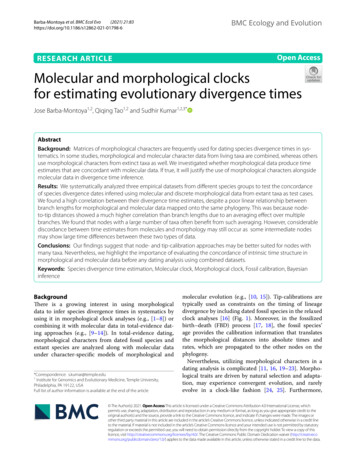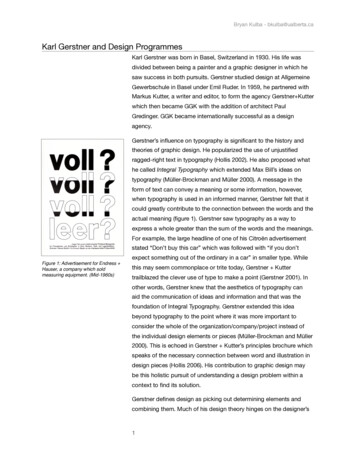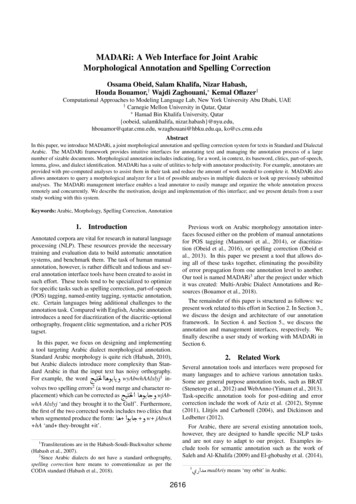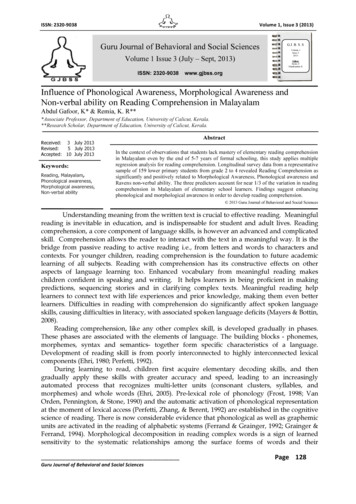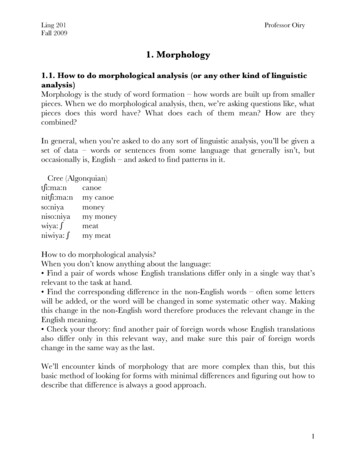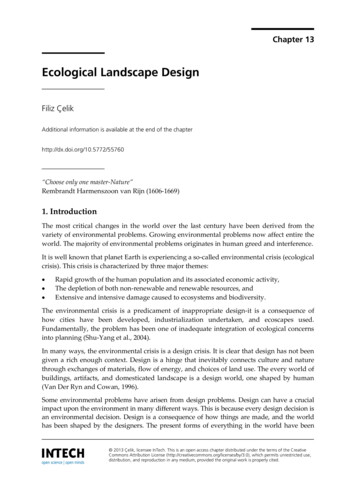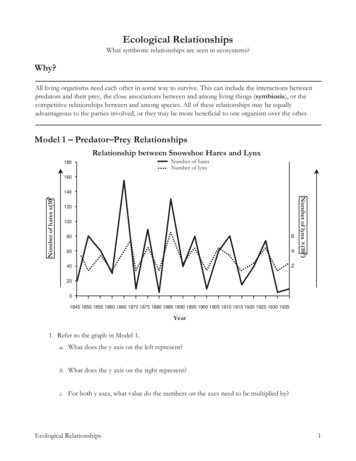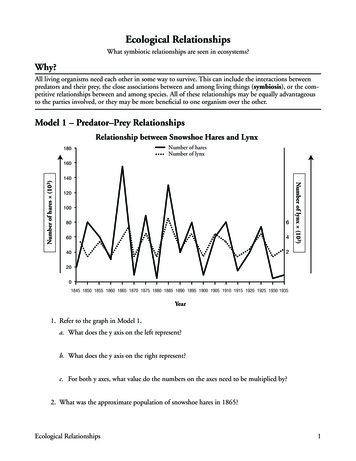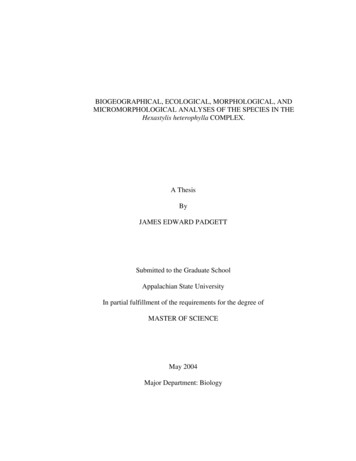
Transcription
BIOGEOGRAPHICAL, ECOLOGICAL, MORPHOLOGICAL, ANDMICROMORPHOLOGICAL ANALYSES OF THE SPECIES IN THEHexastylis heterophylla COMPLEX.A ThesisByJAMES EDWARD PADGETTSubmitted to the Graduate SchoolAppalachian State UniversityIn partial fulfillment of the requirements for the degree ofMASTER OF SCIENCEMay 2004Major Department: Biology
BIOGEOGRAPHICAL, ECOLOGICAL, MORPHOLOGICAL, ANDMICROMORPHOLOGICAL ANALYSES OF THE SPECIES IN THEHexastylis heterophylla COMPLEX.A ThesisByJames Edward PadgettMay 2004APPROVED BY:Dr. Zack E. MurrellChairperson, Thesis CommitteeDr. Gary L. WalkerMember, Thesis CommitteeDr. Ray S. WilliamsMember, Thesis CommitteeDr. Vicki J. MartianChairperson, Department of BiologyDr. Judith E. DomerDean of Graduate Studies and Research
Copyright by James Edward Padgett 2004All Rights Reserved
ABSTRACTBIOGEOGRAPHICAL, ECOLOGICAL, MORPHOLOGICAL, ANDMICROMORPHOLOGICAL ANALYSES OF THE SPECIES IN THE Hexastylisheterophylla COMPLEX. (May 2004)James Edward Padgett, B. S. Gardner-Webb UniversityM. S. Appalachian State UniversityThesis Chairperson: Zack E. MurrellThe genus Hexastylis Raf. (Commonly known as “Wild Ginger” or “Little BrownJugs”) is comprised of nine species that are distributed throughout the southeast ofNorth America. Blomquist (1957) and Gaddy (1987) both recognized a group ofeight Hexastylis species as the Virginica Group. Blomquist further divided the groupinto three Subgroups: Virginica, Shuttleworthii, and Heterophylla. Three specieshave been recognized in the Hexastylis heterophylla complex: H. heterophylla (Ashe)Small, H. minor (Ashe) Blomquist and H. naniflora Blomquist. Field biologists havegenerally recognized considerable morphological overlap occurring within this group.Hexastylis naniflora is a federally threatened species and is distributed in one of themost rapidly growing urban and industrial areas of the western Piedmont of Northand South Carolina. The H. heterophylla complex was the focus of this thesisresearch, with an emphasis on the biology of the imperiled species H. nanifloraiv
Herbarium specimens (N 693) borrowed from 17 herbaria were used to generatedistribution maps for the three species in the H. heterophylla complex. Elementaloccurrence data from the North Carolina Natural Heritage Program and the SouthCarolina Heritage Trust Program were obtained to augment the distribution map forH. naniflora. Based upon these maps, field investigations were conducted across thegeographic range of the three species within the complex. Ecological, morphological,micromorphological, soil, and pollen analyses of the H. heterophylla complex wereconducted. Using ecological and biogeographical information obtained from thestudy, we located 31 new populations of H. naniflora. One of these populations wasfound in the Yadkin River drainage where H. naniflora was not previously known tooccur. This study extended the total number of known populations of H. naniflora to143.The three species in the Heterophylla complex were subjected to biosystematicand ecological analyses to explore species boundaries in the group. Eighty-fiverepresentative populations from the three species in the H. heterophylla complex wereexamined in field investigations. Based upon the ecological comparisons, the rangeof H. naniflora appears to be restricted by soil type and/or species co-occurrence.Using Scanning Electron Microscopy (SEM), pollen characters were discovered thatdistinguish H. naniflora from other members of the subgroup. Based uponbiogeographical, ecological, morphological, and micromorphological work, theresults show that H. naniflora is a well-defined species, while Hexastylis minor andH. heterophylla exhibit considerable morphological and micro-morphologicaloverlap, making species circumscription difficult.v
ACKNOWLEDGEMENTSThere are many individuals and organizations I would like to acknowledge forboth their assistance and guidance through my education and research.The first three individuals I want to acknowledge were mentors and educators, aswell as friends. Dr. Wayne Hutchings, former professor at Isothermal CommunityCollege was the first person to spark my interest in biology and later botany. Dr.Thomas H. Jones, Chair of the Biology Department at Gardner Webb University,introduced me to the world of plant systematics and taxonomy. He also encouragedme to grow as a botanist by helping me pursue a floristic study at the Broad RiverGreenway, where I first encountered Hexastylis. Finally, Dr. Zack E. Murrell, myadvisor while at Appalachian State University, allowed me to take my love andinterest with the rare plant Hexastylis naniflora (Dwarf-flowered Heartleaf) and use itas the basis for my research at ASU. His guidance and insight, as well as constructivecriticism, were very valuable to me during this project.There are a number of other individuals who were important in helping guide meduring this project. My thesis committee members Dr. Gary Walker and Dr. RayWilliams were valuable for guidance and support while at ASU. Emily Parisher andSeth Peoples were of great importance to me personally, as well as to my research.vi
They were helpful in the field, for comic relief, or for allowing me to crash at theirplace when I needed a place to relax and sleep.Emily Parisher was especially important to me as a field assistant. She traveledwith me across North and South Carolina helping with vegetation surveys. She wasexcellent when it came to recording data and helping to identify vegetation at themany sites we surveyed. Seth Peoples was my sounding board and person I turned towhen I needed a break from my research. We spent many nights listening to LedZeppelin and talking about family and friends.Also from ASU, were a number if individuals whom I want to acknowledge whowere of great assistance in helping me in my research. They are Dr. Ruth Dewel, Dr.Mary Connell, Dr. Howard Nuefeld, Dr. Robert Creed, Ms. Emily Gillespie, Mrs.Joanne Holden, Ms. Betsy Harris, Mrs. Vickie Issacs, Ms. Karen Bost, Mr. ScottTaylor, Mr. Alex Martin, Mr. John Sealy, Ms. Kristen Bright, and Ms. DaphneGensberg.Other individuals, I would like to acknowledge are L. L. Gaddy from theUniversity of South Carolina in Columbia, Dr. Gil Newberry from the University ofSouth Carolina in Spartanburg, Mr. Henry Edwards, owner of the Kudzu Farm, Dr.Doug Rayner from Wofford College in Spartanburg, Dr. Tim McDowell from EastTennessee State University, Mrs. Jame Amoroso and Mr. Shawn Oakley from theNorth Carolina Natural Heritage Program, Mr. Hal Bain and Ms. Karen Lynch fromthe North Carolina Department of Transportation, Dr. Cecil Frost and Ms. MarjBoyer from the North Carolina Department of Agriculture, Dr. Bert Pitman, Mr. JimSorrow, and Ms. Mary Bunch from the South Carolina Heritage Program, Dr. Robertvii
Peet from The University of North Carolina at Chapel Hill, Mrs. Brownie Plasterfrom the Broad River Greenway Council, and Dr. Alan Ratzlaff from the UnitedStates Fish and Wildlife Service.I would also like to acknowledge and thank my wife Joyce Padgett. It was withgreat sacrifice on her part that I was able to pursue my dreams and goals regardingmy interest and love of science. Without her love and support none of this wouldhave been possible. Along with my wife, the love and support of my children Jessicaand Brandon cannot go unmentioned.There are many organizations and agencies to whom I own a debt of gratitude forall the advice, permits, valuable information, and funding they provided to myresearch. The North Carolina Department of Transportation (NCDOT), the NorthCarolina Department of Agriculture Plant Protection Program, the North CarolinaNatural Heritage Program, the South Carolina Natural Heritage Program, the UnitedStates Fish and Wildlife Service (USFWS), Cowpens National Battlefield, theCatawba Lands Conservancy, the United States Forest Service (USFS), Crowder’sMountain State Park, Kings Mountain State Park, Rhyne Nature Preserve, the CratusD Williams Graduate School, Bunched Arrowhead Heritage Preserve, Peters CreekHeritage Preserve, Dan River Inc., Spartanburg County Waterworks, Broad RiverGreenway, Cleveland County Landfill, Clemson Soil Lab, Association of SouthernBiologists (ASB), United States Department of Agriculture (USDA), ASU BiologyGraduate Student Association , and the Southern Appalachian Botanical Society(SABS). Herbaria that graciously allowed me to examine specimens are listed byname and acronym: Appalachian State University (BOON), Converse Collegeviii
(CONV), Duke University (DUKE), East Tennessee State University (ETSU), GrayHerbarium (GH), Gardner Webb University (GWU), Missouri Botanical Garden(MO), New York Botanical Garden (NY), North Carolina State University (NCSU),University of Georgia (UGA), University of North Carolina at Chapel Hill (UNCH),United States National Herbarium (US), University of South Carolina at Columbia(USCH), University of South Carolina at Spartanburg (USCS), University ofTennessee Knoxville (TENN), University of Wisconsin at Madison (UWI), VirginiaPolytech Institute (VPI) and Wofford College (WOFF).ix
TABLE OF CONTENTSPageAbstractiiiAcknowledgementsvList of TablesxiList of n75Bibliography86Appendix A93Appendix B108Appendix C112Appendix D114Vitae127x
LIST OF TABLESPage1. Hexastylis groups and subgroups142. List of Herbaria for annotated specimens183. NCVS Sites274. Soil sample sites325. Species richness data626. GLM results for species richness637. Associate species H. heterophylla complex708. GLM results on soils718. Tukey’s results on soils72xi
LIST OF FIGURESPage1. Diagram of Asarum clade by L. Kelly.132. Diagram showing flower measurements233. Diagram of NCVS Plot294. Distribution Map for H. naniflora395. Distribution Map for H. heterophylla Complex416. New H. naniflora population distribution map437. River Drainage Distribution Map for H. naniflora458. PCA results from H. minor and H. naniflora479. PCA results from H. heterophylla and H. naniflora4910. PCA results from H. heterophylla and H. minor5111. PCA results from H. heterophylla complex5312. Pollen micrographs of the H. heterophylla complex5513. H. heterophylla pollen close up5714. H. minor pollen close up5915. H. naniflora pollen close up6116. Average species diversity6517. Sorenson’s Index results6718. Dendrogram from results of Sorenson’s analysis69xii
LIST OF FIGURES (continued)Page19. Transplant survival74xiii
1INTRODUCTIONSpecies recognition and delineation is a critical part of conservation biology. If we areto use species as our unit of conservation, we must be able to determine if the unit is a“good species.” There is considerable literature addressing the question, “What is aspecies?” (Avise and Wollenburg 1997; Bridle and Richie 2001; Britton-Davidian 2001;Noor 2002; Orr 2001; Riesenberg and Burke 2001; Rundle 2001; Shaw 2001; Vogler2001; Wu 2001). However, most studies are theoretical and very few address the issue ofspecies in “real life” settings. I contend that there is a critical need to examine imperiledspecies to determine if they can be defended as biological units. This effort is necessaryin order to show the public that the funds invested in species conservation are worth thecosts as well as the effort.There is also a critical need in conservation biology to determine the autecology ofimperiled species. This effort is necessary in order to 1) maintain and/or extend the rangeof imperiled species in a time of ever-dwindling non-disturbed habitat, and 2) to preparefor not-too-distant future needs to reconstruct whole alliances of organisms in the face ofclimatic change and wholesale movement of appropriate microhabitat from currentlocations. If we fail to gain this information in the near future, we will not be prepared toadequately protect imperiled species through the 21st century. In my study I examinedspecies boundaries and autecology of the federally threatened Hexastylis nanifloraBlomquist in the family Aristolochiaceae (Department of the Interior 1989). This species
2appears to be closely related to two other species with sympatric distributions, Hexastylisminor and Hexastylis heterophylla. I used a variety of morphological and ecologicalanalyses to elucidate relationships among these three species, to examine the rarity of H.naniflora, and to develop a management plan that will ensure that this species is not indanger of extinction.The family Aristolochiaceae, also known as the Birthwort family, consists of eightgenera with more than four hundred species (Judd et al. 2002). The distribution ofAristolochiaceae is primarily pantropical with a few species found in temperate regionsof Asia, Europe, and North America. The two major genera in the family areAristolochia with 300-350 species and Asarum with about 70 species (80 if Hexastylisand Heterotropa are included).Most of the family consists of climbing woody vines in Aristolochia, which has atropical distribution. Asarum occurs in North America and Asia and consists ofherbaceous perennial and annual species. Asarum species often have aromatic stems orleaves, due in part to the ethereal oils many of them possess.Depending on the authority used, the North American species of Hexastylis can besegregated as a separate genus or nested within Asarum. After the genus Hexastylis wasfirst segregated from Asarum by Rafinesque (1825), it slowly gained general acceptancein the North American literature (Blomquist 1957; Britton and Brown 1947; Cronquist1981; Gaddy 1981, 1986a, 1986b, 1987; Gonzalez 1972; Kral 1983; Otte 1977; Radfordet al 1968; Rayner 1994; Small 1933; Wofford 1989). Hexastylis was segregated fromAsarum primarily due to the persistent glabrous leaves and the unique ovary position
3(Rafinesque 1825). Currently, Hexastylis is commonly used to describe a genus of ninespecies and four varieties that is endemic to the southeastern United States.In spite of this general acceptance, several North American taxonomists refused torecognize Hexastylis as a genus and published their work using the genus Asarum(Fernald 1943, 1950; Gregory 1956; Peattie 1929, 1940; Wyatt 1955). Barringer (1993)stated that new nomenclatural combinations were needed for North American species ofAsarum to align them with the current understanding of the genus and he revised thegenus Asarum and placed the genus Hexastylis in synonymy. In transferring the speciesof Hexastylis to Asarum, Barringer (1993) expanded the genus Asarum to 80 species.Barringer (1993) noted that all of the Asarum are linked together by similar vegetativeand reproductive characteristics, as well as having similar ethereal oils, as was firstdetermined by Hayashi et al. (1982). Recent molecular work by Kelly (1997, 1998a,1998b) has shown Hexastylis nested within the genus Asarum, further supporting thework of Barringer (1993).The recent publication of the Flora of North America (FNA) again recognizedHexastylis as a separate genus apart from Asarum, but footnotes were added in both theHexastylis and Asarum keys and descriptions to denote that some problems existed in ourunderstanding of the phylogeny (Barringer 1993; Whittemore and Gaddy 1997).One of the earliest descriptions and illustrations of Asarum was in an herbal byDodoens (1574) who discussed the use of Asarum as a purgative. He noted the medicinalproperties of the plant he called Asaron (Asarum europaeum). In the 17th century otherherbals and botanical journals described several species of Asarum (Parkinson 1640;Tournefort, 1694). In 1789, de Jussieau recognized a relationship between Asarum, a
4genus made up entirely of herbs, with Aristolochia, a large genus comprised almostentirely of woody vines. De Jussieau (1789) made these associations based on floralcharacteristics and plant morphology. In Species Plantarum Linnaeus (1753) describedfour species of Asarum, including two North American species, Asarum canadense L.,and Asarum virginicum L. Andre Michaux (1803) published a description of a thirdNorth American Asarum he named Asarum arifolium Michx.In 1825, when Rafinesque erected the genus Hexastylis, his circumscription was basedon characters that were unique to the three or four known North American species ofAsarum. Those characters used to delineate Hexastylis included glabrous persistentleaves, connate sepals, sessile anthers, and apical bifid styles. Based on those characters,Rafinesque (1825) segregated Hexastylis virginica (L.) Raf., and Hexastylis arifolia(Michx.) Raf., leaving A. canadense as a sole species in the genus Asarum in NorthAmerica. Rafinesque’s (1825) description of Hexastylis in Neogenyton is as follows:“Hexastylis. Cal. Tubular, trifid, cor o. anthers twelve, sessile,bilobe adnate, epigyne; pistil half free, cylindrical, and concave;styles six, lateral erect; stigmas six, truncate, oblique, bicorne;caps. Six locul. Few central seeds. Type Asarum arifolium,Michx.”Morren and Decaisne (1834) erected the genus Heterotropa, and described the Asianspecies Heterotropa asarodies Morr. & Dec. The characters used by Morren andDecaisne (1834) to describe Heterotropa were very similar to those used by Rafinesque(1825) to describe Hexastylis. Braun (1861) was the first to recognize the similarity inthe descriptions of the two genera and placed both Hexastylis and Heterotropa insynonymy within Asarum. Braun divided the genus Asarum into three sections:
5Ceratasarum, Heterotropa, and Euasarum and placed Hexastylis within sectionCeratasarum, which included A. arifolium and A. virginicum along with one Japanesespecies, Asarum variegatum. Duchartre (1864) closely followed Braun’s treatment in A.P. de Candolle’s publication Prodromus Systematis Naturalis Regni Vegetabilis whichwas quoted in Braun’s 1861 publication.In the late 19th century W. W. Ashe traveled extensively across much of thesoutheastern United States examining various plant communities. In his travels Asherealized that separation of the species of Asarum was difficult and the genus exhibitedconsiderable variation across its range. Seeing that many specimens did not fit within thecircumscription for A. virginicum, Ashe started collecting Asarum throughout thesoutheast United States. He also made numerous notes and sketches in regards to flowerand leaf morphology. Ashe (1897) described several species of Asarum, including twospecies that would eventually be placed into the Virginica group of Hexastylis. Ashe’s(1897) description of the three new species is as follows:“Asarum minus. Leaves solitary, glabrous, think, round cordateat base, but rarely orbicular. Tube of calyx cylindrocampanulate, about 1 cm wide, about the same length, thevery sort lobes spreading. Peduncle as long as flower, the largeract pointed. Projection of style very short; the seeds oblong.”“Asarum heterophyllum. Leaf-blades orbicular, ovate ortriangular in outline, cordate at base (or occasionally almosthastate), about the same size as in above. Calyx campanulaterounded at the base, the tube. 7-1 cm long, the lobes nearlyequaling in length .8-1 cm wide at the base, orange-purple orpurple-brown without, bright within; the very stout notchedstyle much prolonged the much minute round stigma; capsuleshort, cylinderous barely as long as the stamens, scarcelydistending the calyx; seeds oval.”
6“Asarum heterophyllum ochranthum. Calyx yellow or orange,oblong-campanulate, the spreading lobes as long as the 1cmtube. Calyx urceolate or somewhat contracted at the mouth, theoval stigma thicker than the slender deeply 2-parted projectionof the style, and placed near the base of the style.”Along with the descriptions quoted above, Ashe (1897) also described thedistributions of the three new species. He described the distribution of A. heterophyllumAshe (H. heterophylla) as being from North Carolina, Tennessee, and Virginia.Herbarium records and recent publications show H. heterophylla to be found in Alabama,Georgia, Kentucky, North Carolina, South Carolina, Tennessee, Virginia, and WestVirginia. Asarum heterophyllum ochranthum was never well accepted and today isincluded within H. heterophylla. Asarum minus was described by Ashe (1897) as beingfrom North Carolina, South Carolina and Tennessee and is presently known fromGeorgia, North Carolina, South Carolina, and Virginia (Amoroso 2002; Blomquist 1957;Gaddy 1987; Radford et al, 1968; McMillian 1995; Sutter et al, 1983; Wofford 1989).The genus Hexastylis was not widely recognized in North American publications untilJ. K. Small (1933) used Hexastylis instead of Asarum to denote the genus in his Manualof Southeastern Flora. This was the first major publication of southeastern flora in theUnited States to recognize the genus Hexastylis. After Small’s (1933) publication, theuse of the name Hexastylis became widely accepted for the genus and was recognized inmost North American publications separate from Asarum. In fact, Hexastylis has for themost part replaced Asarum in most North American publications, with very fewexceptions.In Southeast Asia, the treatment of Hexastylis as a separate genus is not accepted andis still not referred to except when used as a synonym or as a common name to denote
7Hexastylis as a southeastern United States endemic. Schmidt (1937) recognized the samefour sections within Asarum that were first erected by Duchartre (1864) and placed thefour sections in two subgenera, Asarum subgenus Heterotropa and Asarum subgenusCeratasarum. Schmidt (1937) also broadened the descriptions of the four sections ofAsarum to allow for many species that had been described since Duchartre (1864) to fitwithin his taxonomic framework. Maekawa (1936) and Maekawa and Ono (1965)worked with Japanese flora and recognized two segregate genera for Asarum. Maekawamoved 45 species from Asarum to Heterotropa and described dozens of new species.Maekawa (1936) erected the genus Asiasarum and placed five newly named species andone variety into that genus. Included in one of those new genera was the newly describedspecies Asarum Japonasarum Nakai (1936). Araki (1937, 1953) divided Asarum intotwo subgenera, Asarum section Asarum, and Asarum section Asiasarum. He furtherdivided Asarum section Asarum into three subsections, Euasarum, Calidasarum, andJaponasarum. With Asarum section Asiasarum Araki erected the three subsectionsAsiasarum, Hexastylis, and Heterotropa.Blomquist (1957) made a complete revision of the genus Hexastylis in North America.Kelly (1998b) suggested that Blomquist (1957) might have overlooked the work of Araki(1953), who merged Hexastylis with the Japanese Asarum. In his treatment, Blomquistkept the genus name Hexastylis, divided the genus into three groups, and then recognizedsubgroups within these groups. Blomquist changed the specific epithet on the name H.minus to H. minor. He work described one new species, which he placed in the subgroupHeterophylla. H. naniflora was described from specimens found in three locations in
8North Carolina and South Carolina. The description of H. naniflora by Blomquist (1957)is as follows:Hexastylis naniflora sp. nov. Leaf-blades cordate to orbicularovate, 4-5.76 cm long by 4-5.5 cm wide, the apices obtuse, thesinuses broad to narrow, the lobes rarely overlapping, usuallyvariegated along the principal veins. Petioles averaging 10.5 cmlong. Rhizomes short and moderately branching. Calycesrelatively small, brown, thr tube cylinderic, slightly narrowingupwards, 7 mm long by 6.5 mm wide in diameter, sometimespale brown above the base, the lobes relatively large, flaring atthe base, 7 mm wide at the base by 5.5 mm long, moderatelyspreading, without colorless spots inside. Stamens essentiallysessile, those opposite the styles conspicuously shorter than thealternating ones. 1.61 mm-1.84 mm long, the anther-connectivenot prolonged into three appendage. Ovary ca. ½ inferior. Stylesca. 2.5 mm long, extending 0.75mm above the stigma, onlynotched at apex. Mature seeds not seen.Recent work by Kelly (1997, 1998a, 1998b, 2001, and 2002) using morphology andmolecular data support the previous Asian studies, has shown that Hexastylis should berecognized within Asarum under the section Heterotropa (see Figure 1). Kelly (1997)conducted molecular analysis on the Internal Transcriber Space (ITS) region of a numberof Asarum species from around the world as well as the southeastern species A.canadense and three species of Hexastylis. His work demonstrated that Hexastylis isrooted within Asarum and should be treated as Asarum. However, due to the localizedstigma associated with the use of the genus name Asarum for Hexastylis, the species inthis paper will be referred to as Hexastylis with the understanding that Hexastylis isrooted in Asarum and the proper treatment of the species complex is within Asarum.Kelly (2002) advocated the use of Asarum and supported the monophyletic arrangementbased on morphological and molecular data. His work supports the broad treatment ofAsarum by Araki (1937, 1953) who recognized two subgenera, Asarum and Heterotropa.
9Figure 1. Phylogeny showing Hexastylis nested within Asarum based on the molecularanalysis preformed by Kelly (1997). Hexastylis is included in Asarum sectionHeterotropa.
10
11The sections Asarum and Geotaenium are included within the subgenus Asarum and thesections Asiasarum and Heterotropa (which includes Hexastylis) are placed within thesubgenus Heterotropa.Hexastylis heterophylla ComplexBy the late 1950’s, Hexastylis was recognized as consisting of eight species that wereendemic to the southeastern United States. Blomquist (1957) established the currentlyrecognized grouping of Hexastylis, and it has become widely accepted, especially bybotanist from the southeastern United States.The genus Hexastylis, as recognized by Blomquist, consists of three groups: Arifolia,Speciosa, and Virginica. The group Arifolia has one species comprised of three varieties.They are H. arifolia var. arifolia, H. arifolia var. ruthii, and H. arifolia var. callifolia.The second group, Speciosa, consists of a single species, H. speciosa that is found only incentral Alabama. The third group, the Virginica group, is divided into three subgroups.Blomquist named the subgroups of this group Virginica, Shuttleworthii, andHeterophylla. The Virginica subgroup recognized by Blomquist contained only H.virginica. Morphological analysis (Gaddy 1987) showed that H. rhombiformis is a closerelative of H. virginica within the Virginica subgroup. Gaddy (1987) allied H.rhombiformis with H. virginica and placed it into the Virginica subgroup. TheShuttleworthii subgroup, as recognized by Blomquist, had two species, H. shuttleworthiiand H. lewisii. Hexastylis shuttleworthii has two recognized varieties, H. shuttleworthiivar. shuttleworthii and H. shuttleworthii var. harperii. The Heterophylla subgroup, asrecognized by Blomquist, contains H. heterophylla, H. minor, and H. naniflora. Gaddy
12(1987) suggest that H. contracta is allied with the Heterophylla subgroup and hesubsequently placed it into this subgroup. The Hexastylis heterophylla subgroup hasbeen thought to form an overlapping complex of species (Blomquist 1957; Gaddy 1987).One of the main concerns regarding this complex was the inability to distinguish betweenspecies without access to fresh flowers. Even with fresh flowers Blomquist (1957) andGaddy (1987, 2003) still recognized considerable overlap in flower morphology in thecomplex making species delineation difficult (see Table 1).Through the 1980’s, Gaddy examined the groups and subgroups of Hexastylis erectedby Blomquist (1957) in closer detail. He retained the framework of groups andsubgroups described by Blomquist (1957), and he added details to the dichotomous keysto aid in the distinction of species within the genus. Along with characteristics known toexist, Gaddy also looked at biogeography and soil types in an effort to resolve specieslevel questions, and verify the validity of species in the H. heterophylla complex.Species Conservation and Conservation RecommendationsThe rarity of H. naniflora has prompted the protection of a number of sites. TheSpartanburg County Water Works in South Carolina was among the first organizations tosee the significance of protecting H. naniflora. They placed over 1,000 plants intoprotection in the late 1980’s. Camp Mary Elizabeth, also in Spartanburg County, isanother site where a considerable number of H. naniflora individuals have beenprotected. In the early 1990’s, through the efforts of Dr. Gil Newberry with theUniversity of South Carolina at Spartanburg, H. naniflora was found to exist at theCowpens National Battlefield in Cherokee County, South Carolina, around Lake Blalock,and around Lake Saranac, in Spartanburg County, South Carolina. These sites
13Table 1. Hexastylis groups and subgroups recognized by Blomquist (1957) andGaddy (1987).GROUPSARIFOLIASUBGROUPSSPECIOSAVIRGINICA VIRGINICASPECIESHexastylis arifolia var. arifolia(Michx.) SmallHexastylis arifolia (Michx.) Small var.callifolia (Small) BlomquistHexastylis arifolia (Michx.) Small var.ruthii(Ashe) BlomquistHexastylis speciosa HarperHexastylis virginica (L.) SmallHexastylis rhombiformis GaddySHUTTLEWORTHIIHexastylis shuttleworthii var.shuttleworthii (B. & B.) SmallHexastylis shuttleworthii var. harperii(B. & B.) GaddyHexastylis lewisii (Fernald)Blomquist and OostingHETEROPHYLLAHexastylis heterophylla (Ashe) SmallHexastylis minor (Ashe) BlomquistHexastylis naniflora BlomquistHexastylis contracta Blomquist
14now allow for the protection of several thousand plants. The South Carolina Departmentof Natural Resources in South Carolina ultimately purchased and now manages a 161acre tract of land in Spartanburg County that was developed into the Peters CreekHeritage Preserve. This preserve contains well over a thousand H. naniflora plants.In North Carolina, the Henson’s Ravine Natural H
Blomquist in the family Aristolochiaceae (Department of the Interior 1989). This species . 2 appears to be closely related to two other species with sympatric distributions, Hexastylis minor and Hexastylis heterophylla. I used a variety of morphological and ecological
